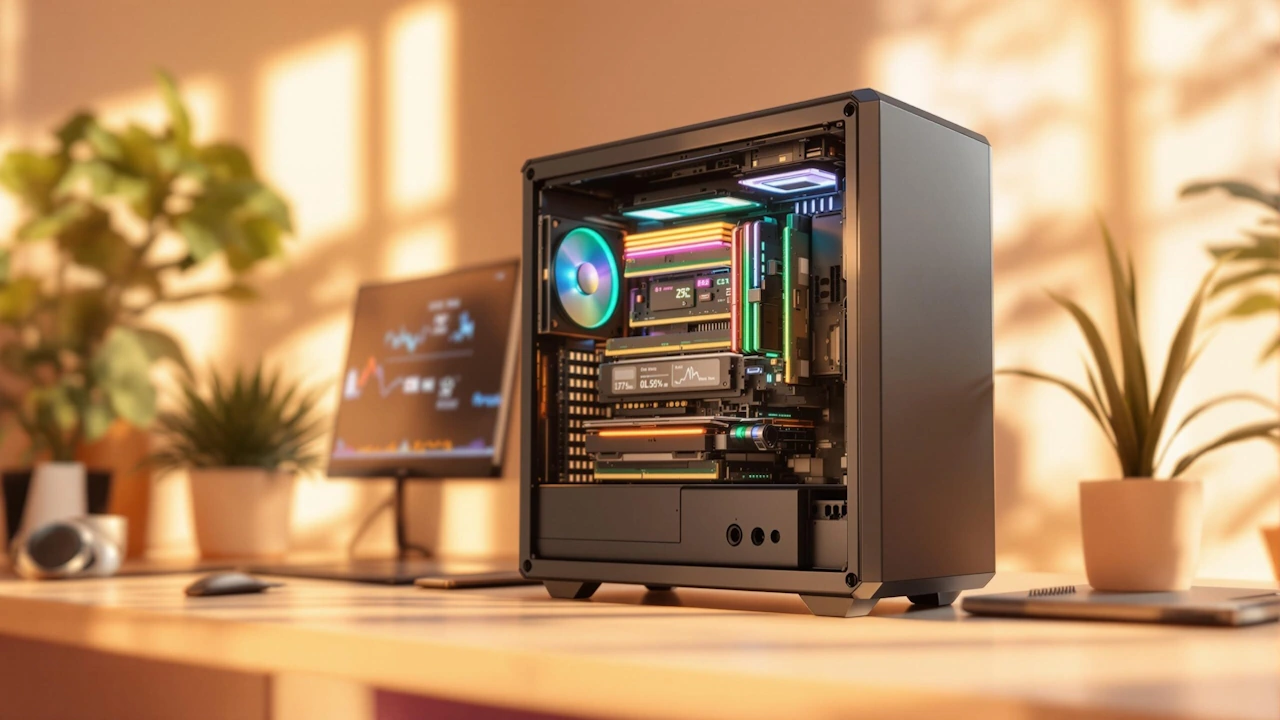Upgrade Solutions
RAM Upgrade Guide: How Much Memory Does Your PC Need?
RAM Upgrade Guide: How Much Memory Does Your PC Need?
Want to speed up your PC? Upgrading RAM is often the easiest fix.
Here’s what you need to know:
-
Basic tasks (web browsing, emails): 8GB is enough.
-
Gaming (modern titles): Go for 16GB.
-
Content creation (video editing, 3D modeling): Start with 32GB.
-
Professional workstations (virtual machines, rendering): 32GB or more.
How to check your RAM needs:
-
Open Task Manager (Windows) or Activity Monitor (Mac) to see current RAM usage.
-
If your system is maxing out, it’s time for an upgrade.
Compatibility matters:
-
Check your motherboard’s RAM type (DDR4 or DDR5), speed limits, and slot configuration.
-
Use tools like Crucial System Selector to find compatible RAM.
Installation is simple:
-
Power off your PC and discharge static.
-
Insert RAM in the correct slots.
-
Boot up and check BIOS to confirm new memory.
Upgrading RAM can solve slowdowns, improve multitasking, and enhance overall performance. Read on for detailed steps, compatibility tips, and testing methods.
A Beginners Guide: Upgrading Your PC’s RAM
How Much RAM Do You Need?
Now that you know how to monitor your RAM, let’s figure out the right amount of memory for your PC.
The amount of RAM you need depends on how you use your computer. Here’s a breakdown of common scenarios:
Common PC Usage Types
-
Basic tasks like web browsing and editing documents usually work fine with 8GB of RAM.
-
Gaming, especially modern AAA titles, runs smoothly with 16GB.
-
Professional work such as 4K video editing or 3D modeling often requires 32GB or more.
Checking Your RAM Usage
Use your system’s Task Manager (Windows) or Activity Monitor (Mac) to track how much RAM you’re using during your typical tasks. This helps you see if you’re hitting your memory limits.
RAM Size Guide by Use Case
| Usage Type | Recommended RAM | Common Applications |
|---|---|---|
| Basic Computing | 8GB | Chrome, Office Suite, Spotify |
| Gaming | 16GB | Modern AAA Games, Steam, Discord |
| Content Creation | 32GB | Adobe Creative Suite, DaVinci Resolve |
| Professional Workstation | 32GB+ | 3D Rendering, Virtual Machines |
If you notice your system frequently pushing its memory to the limit, it might be time to upgrade. Adding more RAM can help prevent slowdowns and keep your PC running efficiently.
Selecting Compatible RAM
Upgrading your RAM can boost your system’s performance, but you need to pick modules that work well with your setup. Here’s what to focus on.
RAM Types and Motherboard Support
Motherboards are built to support specific RAM generations. Right now, DDR4 is the go-to standard, while DDR5 is the latest option on the market. These two types aren’t interchangeable because they run on different voltages and speeds.
| RAM Generation | Standard Voltage | Typical Speed Range | Availability |
|---|---|---|---|
| DDR4 | 1.2V | 2133–4800 MHz | Commonly Used |
| DDR5 | 1.1V | 4800–6400 MHz | Newer Option |
To find out what your motherboard supports, check the manual or visit the manufacturer’s website with your model number. Once you know the compatible type, think about how speed and timings impact performance.
Memory Speed and Timing
RAM speed, measured in MHz, and timings (like 16-18-18-36) play a role in how well your system runs. Stick with modules that match or fall under your motherboard’s maximum supported speed. If you go for higher-speed RAM, you might need to tweak settings for overclocking.
Memory Channel Setup
Your motherboard’s channel configuration also matters. Most boards work best with a dual-channel setup. For optimal results, install matched pairs, like 2×8GB instead of a single 16GB stick. Make sure the modules are from the same brand and have identical speeds and timings. Check your motherboard manual for the correct DIMM slot arrangement.
Tools like Crucial’s System Selector can help you double-check compatibility.
RAM Installation Steps
Here’s how to safely upgrade your RAM.
Safety and Tools
Set up a static-free workspace and gather these tools:
| Tool/Item | Purpose |
|---|---|
| Phillips-head screwdriver | To remove the PC case panels |
| Anti-static wrist strap | Protects components from static shock |
| RAM modules | Your new memory upgrade |
| System manual | Helps identify the correct RAM slots |
Place your computer on a clean, hard surface, avoiding carpets or other static-prone materials. Unplug all cables and press the power button for about 5 seconds to discharge any leftover electricity. Once prepped, you’re ready to install the RAM.
Installing RAM Modules
The RAM slots are located near the CPU socket. For the best performance, motherboards often have a preferred slot order.
Handle the RAM modules by their edges to avoid damaging the components. Follow these steps:
-
Open the retention clips on both ends of the RAM slot.
-
Align the module with the slot, ensuring the notches match.
-
Press down firmly and evenly until the module clicks into place.
-
Check that the retention clips are fully secured.
For dual-channel setups, install matching pairs in the same-colored slots, typically marked as A1 and B1. If you’re adding to existing RAM, make sure the new modules match your current memory’s specs.
If the module doesn’t fit easily, stop and double-check the alignment. Forcing it can cause damage. A properly installed module will sit flat and the retention clips will lock securely.
After installation, reconnect the power and check the BIOS to confirm the system recognizes the new RAM. Once confirmed, proceed to run memory tests.
Testing New RAM
Once you’ve installed the modules, it’s time to check their performance and ensure everything is working properly.
BIOS Memory Settings
Restart your computer and press F2, Delete, or Esc to enter the BIOS. Navigate to the Memory Settings section, which may be labeled differently depending on your BIOS.
Here are the key settings to review:
| Setting | Purpose | What to Do |
|---|---|---|
| Memory Detection | Confirms installation | Check total installed capacity |
| XMP Profile | Activates rated speed | Enable if supported by your RAM |
| Memory Frequency | Sets operating speed | Match it to your RAM specifications |
After confirming these settings in the BIOS, boot into your operating system to ensure the changes have been applied.
System Memory Status
Once you’re in the operating system, use built-in tools to confirm the new RAM is recognized.
Press Ctrl + Shift + Esc to open Task Manager. Go to the Performance tab and click on Memory. Check the following details:
-
Total installed RAM
-
Current memory speed
-
Number of slots in use
-
Memory type (e.g., DDR4)
For a more thorough check, you can also use the Windows Memory Diagnostic tool.
Memory Stability Tests
To guarantee your system’s stability with the new RAM, perform some memory stress tests.
Use Memtest86 from a bootable USB drive. Let it run for at least 4 hours to check for issues like data corruption, timing errors, or other anomalies. If any errors are detected, test each RAM stick individually to identify the faulty one. Even a single error could point to a hardware problem that may require either an RMA replacement or adjustments in the BIOS settings.
For everyday use, monitor your system’s performance by keeping Task Manager open while running regular applications. Watch memory usage and ensure your system operates smoothly with the new configuration.
Conclusion: Next Steps After RAM Upgrade
Once you’ve upgraded and tested your RAM, it’s important to keep your system running smoothly. Start by checking your system settings – make sure the BIOS recognizes the new memory and enable features like XMP profiles for optimal performance.
Keep an eye on your memory usage. Use tools like Task Manager or Windows Memory Diagnostic to monitor performance. If you notice any instability, run a tool like Memtest86 to identify potential issues. Regularly clear temporary files and update your drivers to prevent problems before they arise.
If your system still feels sluggish, the issue might not be with your RAM. Consider upgrading other components, like replacing a mechanical hard drive with an SSD, to boost overall responsiveness.
FAQs
How do I know what RAM is compatible with my motherboard?
To figure out which RAM works with your motherboard, start by checking the QVL (Qualified Vendor List) provided by your motherboard’s manufacturer. This list outlines the RAM modules tested and confirmed to work with your board.
Here are the key factors to consider:
| Factor | What to Check | Example |
|---|---|---|
| Type | DDR generation supported | DDR4 or DDR5 |
| Max Speed (MHz) | Highest supported speed | 3200MHz, 6000MHz |
| Capacity per Slot | Maximum RAM per slot | 16GB, 32GB |
| Max Capacity | Total system memory limit | 128GB |
These details help narrow down your options. You can also use tools like the Crucial System Selector to find compatible RAM easily.
"After installing new RAM, you may need to enter the BIOS to ensure it is configured correctly. This includes enabling the XMP (Extreme Memory Profile) to allow the RAM to run at its advertised speed rather than the default speed."
Additional Tips for Compatibility:
-
Make sure the RAM’s speed (MHz) is within your motherboard’s supported range.
-
If you’re adding new RAM, match its specifications (type, speed, and capacity) with your existing modules.
-
Check the number of available slots and the maximum capacity each slot can handle.
Keep in mind, while RAM within the same generation is usually backward compatible, running it at speeds higher than your motherboard supports could lead to system instability.

